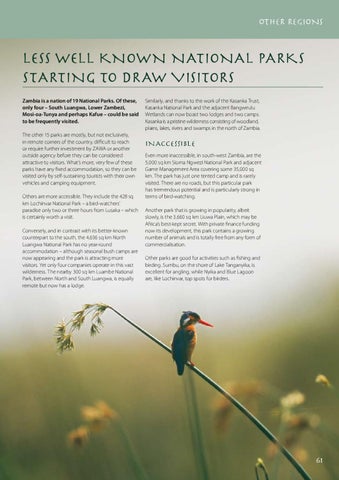OTHER REGIONS
Less well known National Parks starting to draw visitors Zambia is a nation of 19 National Parks. Of these, only four – South Luangwa, Lower Zambezi, Mosi-oa-Tunya and perhaps Kafue – could be said to be frequently visited. The other 15 parks are mostly, but not exclusively, in remote corners of the country, difficult to reach or require further investment by ZAWA or another outside agency before they can be considered attractive to visitors. What’s more, very few of these parks have any fixed accommodation, so they can be visited only by self-sustaining tourists with their own vehicles and camping equipment. Others are more accessible. They include the 428 sq km Lochinvar National Park – a bird-watchers’ paradise only two or three hours from Lusaka – which is certainly worth a visit. Conversely, and in contrast with its better-known counterpart to the south, the 4,636 sq km North Luangwa National Park has no year-round accommodation – although seasonal bush camps are now appearing and the park is attracting more visitors. Yet only four companies operate in this vast wilderness. The nearby 300 sq km Luambe National Park, between North and South Luangwa, is equally remote but now has a lodge.
Similarly, and thanks to the work of the Kasanka Trust, Kasanka National Park and the adjacent Bangweulu Wetlands can now boast two lodges and two camps. Kasanka is a pristine wilderness consisting of woodland, plains, lakes, rivers and swamps in the north of Zambia.
INaccessible Even more inaccessible, in south-west Zambia, are the 5,000 sq km Sioma Ngwezi National Park and adjacent Game Management Area covering some 35,000 sq km. The park has just one tented camp and is rarely visited. There are no roads, but this particular park has tremendous potential and is particularly strong in terms of bird-watching. Another park that is growing in popularity, albeit slowly, is the 3,660 sq km Liuwa Plain, which may be Africa’s best-kept secret. With private finance funding now its development, this park contains a growing number of animals and is totally free from any form of commercialisation. Other parks are good for activities such as fishing and birding. Sumbu, on the shore of Lake Tanganyika, is excellent for angling, while Nyika and Blue Lagoon are, like Lochinvar, top spots for birders.
61
